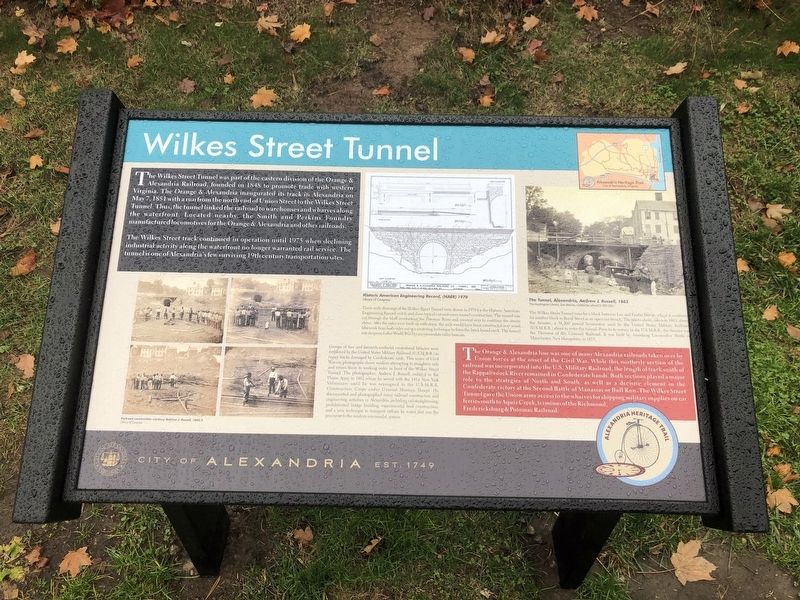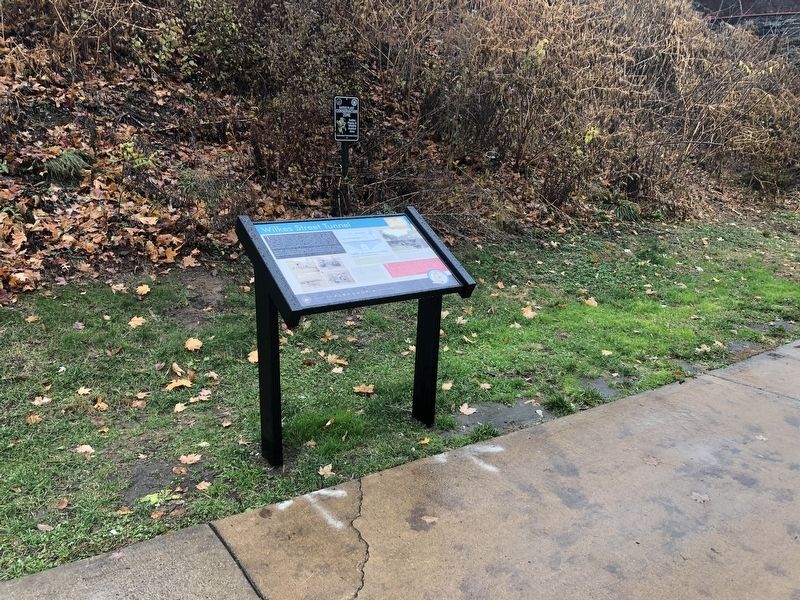Old Town in Alexandria, Virginia — The American South (Mid-Atlantic)
Wilkes Street Tunnel
City of Alexandria Est. 1749
— Alexandria Heritage Trail —
The Wilkes Street Tunnel was part of the eastern division of the Orange & Alexandria Railroad, founded in 1848 to promote trade with western Virginia. The Orange & Alexandria inaugurated its track in Alexandria on May 7, 1851 with a run from the north end of Union Street to the Wilkes Street Tunnel. Thus the tunnel linked the railroad to warehouses and wharves along the waterfront. Located nearby, the Smith and Perkins Foundry manufactured locomotives for the Orange & Alexandria and other railroads.
The Wilkes Street track continued in operation until 1975 when declining industrial activity along the waterfront no longer warranted rail service. The tunnel is one of Alexandria's few surviving 19th century transportation sites.
The Orange & Alexandria line was one of many Alexandria railroads taken over by Union forces at the onset of the Civil War. While this northerly section of the railroad was incorporated into the U.S. Military Railroad, the length of track south of the Rappahannock River remained in Confederate hands. Both sections played a major role in the strategies of North and South, as well as a decisive element in the Confederate victory at the Second Battle of Manassas or Bull Run. The Wilkes Street Tunnel gave the Union army access to the wharves for shipping military supplies on car ferries south to Aquia Creek, terminus of the Richmond, Fredericksburg & Potomac Railroad.
[Captions:]
These scale drawings of the Wilkes Street Tunnel were drawn in 1970 for the Historic American Engineering Record (HAER) and show typical cut-and-cover tunnel construction. The tunnel was cut through the bluff overlooking the Potomac River and covered over to continue the streets above. After the sides were built up with stone, the arch would have been constructed over wood falsework from both sides using a centering technique to form the brick barrel vault. The tunnel was deepened after World War I to accommodate taller boxcars.
The Wilkes Street Tunnel runs for a block between Lee and Fairfax Streets, where it continues for another block to Royal Street as an open cut trench. The photo above, taken in 1863, shows the Senator, a 54,000 pound locomotive used by the United States Military Railroad (U.S.M.R.R.) about to enter the tunnel. Prior to its service in the U.S.M.R.R., the Senator was the Thornton of the Concord Railroad. It was built by Amoskeag Locomotive Works of Manchester, New Hampshire, in 1853.
Groups of free and formerly-enslaved contraband laborers were employed by the United States Military Railroad (U.S.M.R.R.) to repair tracks damaged by Confederate raids. This series of Civil War-era
Erected by City of Alexandria, Virginia.
Topics and series. This historical marker is listed in these topic lists: African Americans • Bridges & Viaducts • Industry & Commerce • Railroads & Streetcars • Roads & Vehicles • War, US Civil • Waterways & Vessels. In addition, it is included in the Orange and Alexandria Railroad, and the Virginia, The City of Alexandria series lists. A significant historical date for this entry is May 7, 1851.
Location. 38° 47.993′ N, 77° 2.524′ W. Marker is in Alexandria, Virginia. It is in Old Town. Marker is on South Union Street, 0.1 miles south of Wolfe Street, on the right when traveling south. Touch for map. Marker is at or near this postal address: 428 South Lee Street, Alexandria VA 22314, United States of America. Touch for directions.
Other nearby markers. At least 8 other markers are within walking distance of this marker. African American Neighborhoods in the Civil War (within shouting distance of this marker); Windmill Hill (about 300 feet away, measured in a direct line); Hayti (about 700 feet away); a different marker also named Wilkes Street Tunnel (about 700 feet away); In Memory of Captain Ryan Wojtanowski (about 700 feet away); Orange & Alexandria Roundhouse (about 700 feet away); Alexandria Railroads (about 700 feet away); First Presbyterian Church of Alexandria (about 700 feet away). Touch for a list and map of all markers in Alexandria.
Credits. This page was last revised on January 28, 2023. It was originally submitted on December 10, 2019, by Devry Becker Jones of Washington, District of Columbia. This page has been viewed 364 times since then and 65 times this year. Photos: 1, 2. submitted on December 10, 2019, by Devry Becker Jones of Washington, District of Columbia.

